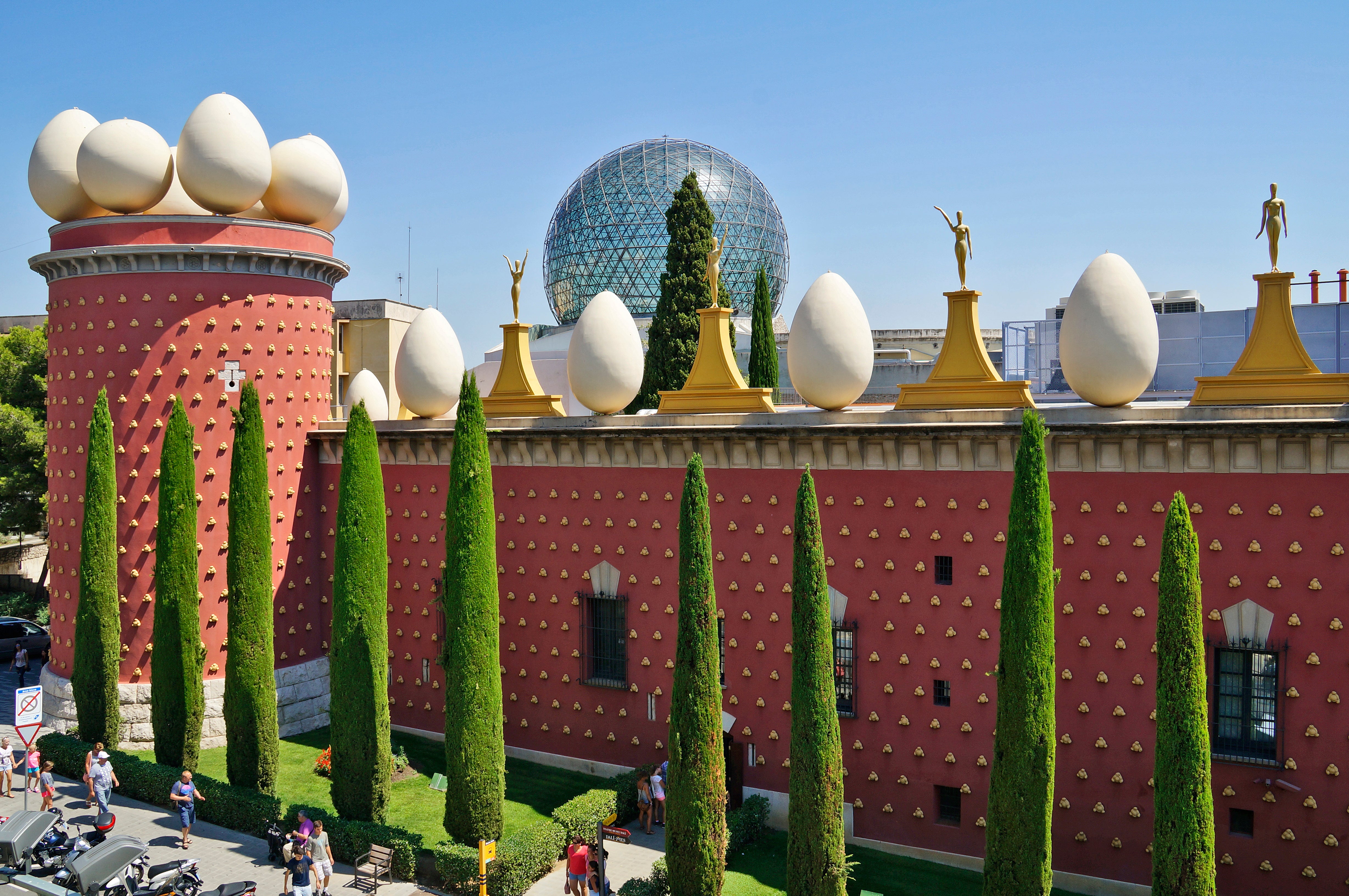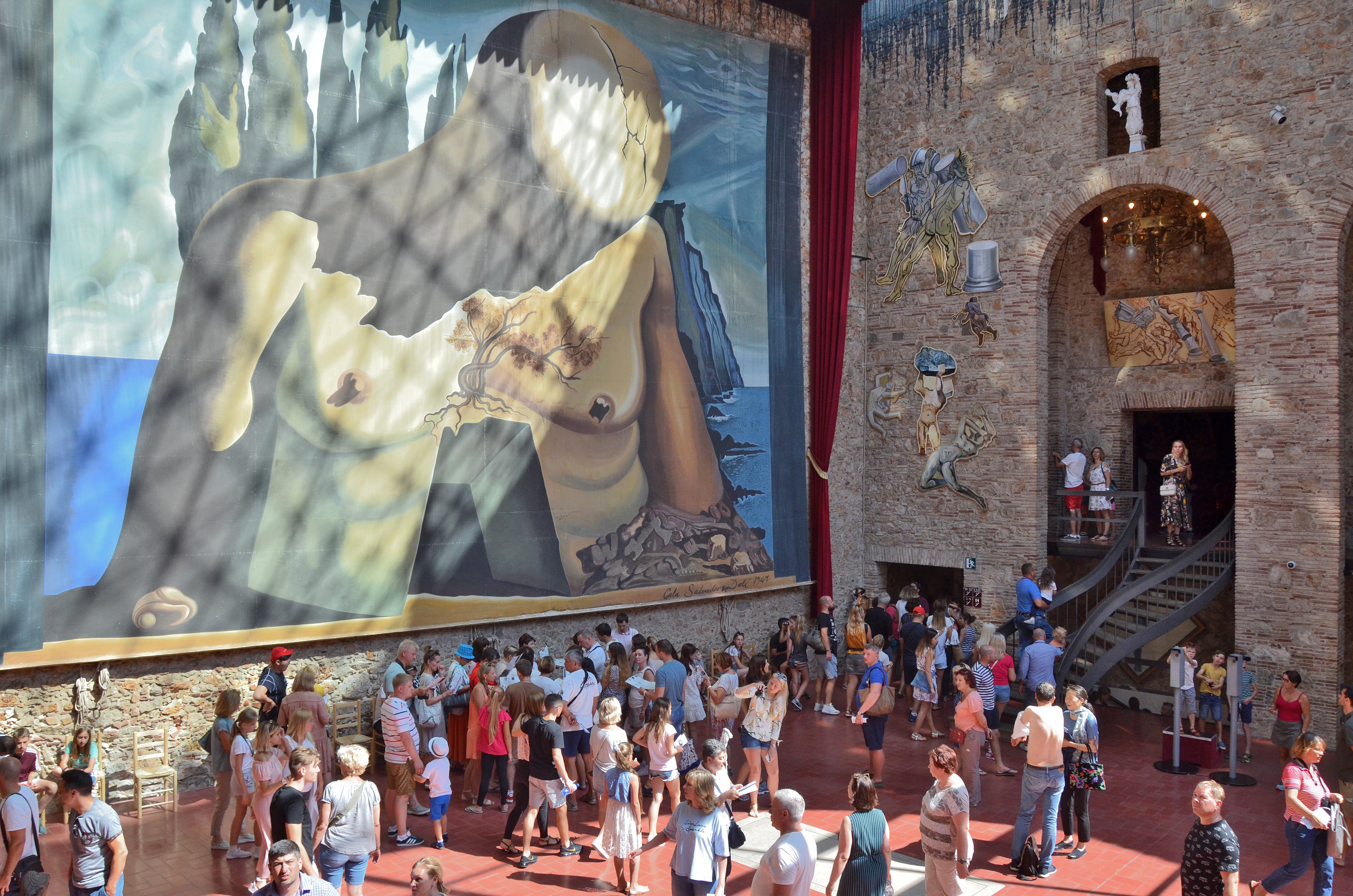Salvador Dalí’s genius wasn’t in his art, it was in his branding
This year marks 120 years since the birth of a titanic figure now known as much for his outrageous antics as his surreal art. Alastair Smart looks back on the life of an artist who taught Warhol about the magic of spectacle

In June 1936, Salvador Dalí travelled to London to give a lecture at the New Burlington Galleries in Mayfair. This was the venue of the recently opened International Surrealist Exhibition, which featured a few of his works. Dalí took to the stage with typical brio: wearing a deep-sea diving suit and helmet, holding two dogs on leads in one hand and a billiard cue in the other.
After a few minutes, it became clear that he was struggling to breathe and at risk of suffocating inside the helmet, which had to be prised off with the billiard cue by a caretaker. This incident is largely remembered as a piece of Surrealist posturing, in the context of a show of Surrealist art. However, it certainly got Dalí talked about, and revealed a gift for marketing that holds the key to his remarkable success.
This year marks the 120th anniversary of his birth, plus the centenary of the launch of the art movement with which he’s synonymous (the poet André Breton published the Surrealist Manifesto in October 1924).
Dalí is also currently the subject of four – yes, four – different “immersive exhibitions” worldwide, where his art is digitally reproduced and projected in 360-degree fashion all over a venue. Fireflies swarm on the walls, giraffes catch fire on the floor, and planets turn into jellyfish on the ceiling.
Dalí duly ranks alongside Claude Monet, Vincent van Gogh and Frida Kahlo in the A-list of artists deemed big enough to justify an immersive show. Such exhibitions travel between major international cities, and in 2022 one of the quartet dedicated to the Spaniard, Dalí: Cybernetics, came to London’s Brick Lane.
The son of a notary, Dalí was born into a well-to-do family in the Catalan town of Figueres in northeast Spain. He seems to have been aware of his talents from early on, writing in his diary, aged 16, “I’m going to be a genius, a great genius, I’m certain of it”.
After studies at the San Fernando Academy of Fine Arts in Madrid, the young Dalí moved to Paris – and though he wasn’t around at Surrealism’s inception, for roughly a decade from 1929 onwards he helped popularise the movement more than anyone.
Perhaps most crucial is the way Dalí seems to have come to believe that his greatest artwork was not a painting; it was himself
His best works are engrossing enigmas: hallucinatory visions where recognisable subjects and objects are portrayed in ostensibly impossible states, settings or combinations.
A well-known example is 1931’s “The Persistence of Memory” (today part of Moma’s collection in New York), a painting dominated by three pocket-watches melting on a beach. Equally famous are the “Lobster Telephone” sculptures from later that decade – which consist of Bakelite telephones with a lobster as the receiver.
Dalí’s work from this period is widely praised. However, the Second World War tends to mark a watershed in critical opinion. Much of his art after it, though popular with the public, is disdained by critics on grounds that it’s – among other things – mannered and repetitive. (Motifs such as melting pocket-watches and spindly-legged elephants, it is said, became a cliche.)
According to John Russell, writing in his obituary of the artist in The New York Times in 1989, Dalí’s “best work became rare to the point of invisibility” in the latter part of his career. “Lucrative… concerns took up much of his time,” Russell added, voicing a broadly held view that money had become the artist’s prime motivation.
In fairness, Dalí did produce impressive work after the War – an obvious example being 1951’s “Christ of St John of the Cross” (owned by the Kelvingrove Art Gallery and Museum in Glasgow and considered one of the most treasured paintings in Scotland). The problem is that each latter-years hit was accompanied by a fair few misses.

Perhaps most crucial, though, is the way Dalí seems to have come to believe that his greatest artwork was not a painting; it was himself. Perhaps he was affected by the fame he found in the US, where he featured on the cover of an issue of Time magazine and where he moved with his wife Gala to escape the War.
Dalí henceforth adopted the role of the madcap eccentric. And it’s for this, as much as for his art, that he’s remembered today.
He drove around in a Rolls Royce packed full of cauliflowers, held press conferences in sewage tunnels, took strolls with anteaters – all with the aim of getting himself noticed.
He starred in countless television commercials too, for products such as Alka Seltzer and Lanvin chocolates, presenting a carefully constructed Dalinian persona: the extravagant genius. At one point he even printed his own newspaper, The Dalí News.
Certain characteristics and accoutrements became a trademark: from the wide-eyed stare and the gilded cane to the supremely-coiffed, upturned moustache. If the world was a stage, Dalí wanted to be chief protagonist, leveraging the power of personal branding decades before the concept was fully developed (and the myriad social-media influencers who harness it today were born).
In this regard, as artist-celebrity, he also clearly inspired Andy Warhol, whom he first met on a trip to New York in 1965 and encountered several times thereafter.

Dalí also grew wont to make outrageous statements – claiming, for example, in his 1976 book, The Unspeakable Confessions Of Salvador Dalí, that “Adolf Hitler turned me on in the highest”. He added that seeing the führer in his tight uniform “aroused in me a delicious gustatory thrill” that brought forth “a Wagnerian ecstasy”.
This and similar comments posthumously saw Dalí on the receiving end of a backlash on TikTok last year (where users described his “fascination with Hitler” as “problematic”).
One feels confident, however, that his words were based in a desire to provoke rather than any deeply felt belief. When it came to achieving career longevity and profitability, Dalí lived by Oscar Wilde’s maxim that the “one thing in the world worse than being talked about… is not being talked about”.
It’s worth stressing that he saw career longevity as extending beyond his own lifetime. To that end, he opened the astonishing Dalí Theatre-Museum in his hometown of Figueres in 1974. (Its 50th anniversary was marked by celebrations this September, overseen by the King of Spain.)
The museum itself remains today very much as Dalí left it, a chaotic funhouse
At its heart are 600 artworks from across his career, given by Dalí to the museum to show. This is no conventional museum, though.
For a start, there’s the building. As its name suggests, it was originally a theatre – only for bomb damage in the Spanish Civil War to leave it in a ruined state in which only Dalí saw potential. He had it reconstructed to his own very specific demands, and to visit the resulting museum is to take a journey inside the artist’s brain.
The journey starts by passing through burgundy-red exterior walls that are topped with sculptures of giant eggs. The museum itself remains today very much as Dalí left it, a chaotic funhouse where works are hung neither chronologically nor thematically, without an explanatory wall label in sight.
Each vista seems designed to trick the eye and the brain. A large painting of Gala looking at the sea, for example, from a certain distance, metamorphoses into a picture of Abraham Lincoln.
Also part of museum is the crypt where Dalí insisted on being buried – which is actually pretty modest compared to the rest of the place. (His body was exhumed in 2017 for the taking of DNA samples, following an ultimately disproved paternity claim. His moustache, remarkably, was still intact.)
The Dalí Theatre-Museum welcomes around 750,000 visitors per year – 15 times the population of Figueres.
“When you’re a genius, you don’t have the right to die,” Dalí once said – and even beyond the grave, he is shaping how his works are experienced. The museum is run by the Gala-Salvador Dalí Foundation, which the artist set up in his final years to tend to his legacy, and which also licenses the aforementioned immersive exhibitions.
What we see throughout Dali’s career, and beyond it, then, is a talent for marketing and self-promotion. Yes, he produced a plethora of iconic artworks in his Surrealist heyday, but he also came to the belief that lasting popularity and success involved more than just producing pictures and sculptures.
As he once told his friend, Antoni Pitxot, the longtime director of the Dalí Theatre-Museum: “Art interests few people, spectacle interests all.”






Join our commenting forum
Join thought-provoking conversations, follow other Independent readers and see their replies
Comments